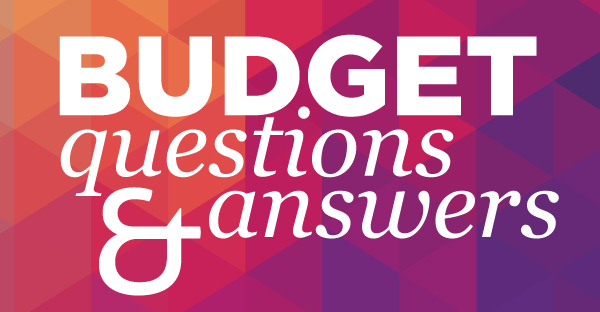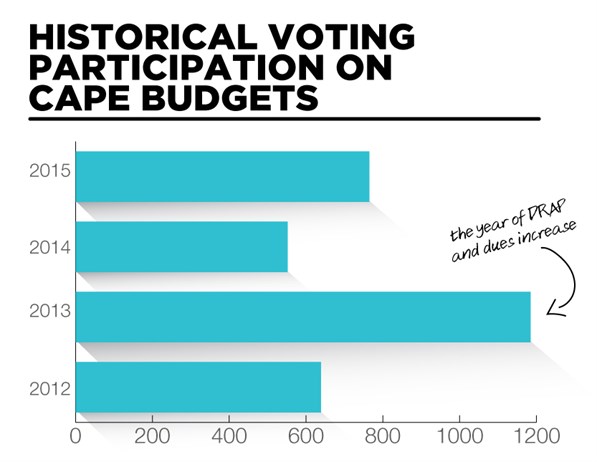Last week, we held a questions-and-answers session on Facebook, acknowledging that while the budget had passed, perhaps our members still had some burning questions. We’re thrilled that members flocked to our Facebook page in droves to ask questions. Here’s a recap of some of the questions we answered. You can see the entire conversation in English here and in French here.
Many members brought up the number of voters on this budget. What do you think of the turnout?
I would love to see more CAPE members engaged, including through the democratic expression of voting on such important matters as the Association's budget. This being said, the participation rate this time around was not much different than that of recent years.
Some members have expressed concerns that the fund might be used for partisan ads during the elections. Others have asked about advocacy advertising versus partisan advertising. What can you tell us about how CAPE intends to raise awareness of our issues with the broader Canadian public?
I think there is a distinction between political/partisan advertising and what we identified as advocacy advertising. The former would specifically be meant to demonize a party or promote another. Advocacy ads, by contrast, would promote a model of public service that resonates with our members – one where advice can be truly fearless and where the best interest of the public at large, not ideology, drives decision-making. We do not intend to use the fund for political advertising.
Can you give us an idea of our current dues structure in the context of the new budget and how it compares to the dues structure of other large unions in the federal public service?
CAPE is one of the only unions in the public service with a fixed-rate dues structure that isn’t tied to employee salary. Consequently, members with lower salaries contribute more proportionally than those with higher salaries. PSAC, but also other unions like the Association of Justice Counsel, pay dues as a percentage of their revenue. The AJC, in fact, has recently voted in favour of a dues increase from 0.75% to 1%, and then 1.25% of salary. For CAPE, the monthly dues rate of $48 is equivalent to 0.6% of salary, on average. In the end, it will be members who will decide how we will adequately fund the defense and strike fund – and that conversation has only just started!
As a single income earner a strike is scary for me. What will this mean in terms of job action?
A strike is indeed a scary prospect, and not one that we wanted to engage in. The new rules imposed by C-4 are however pushing us in that direction if we reach an impasse at the table and the offer put forward by the employer is utterly unacceptable. But what CAPE is doing in establishing the defense and strike fund is sowing the seeds for providing income replacement in case the only way to ensure the protection of our members' rights is taking job action.
We should however remember the positive outcome of the very wise strike that the Foreign service officers carried-out in 2013. They worked to rule, had rotating strike, regular pickets with no income-loss, etc. Job action is an escalation and any form of such action would be the result of a membership vote. You can find out more about the PAFSO strike in our latest mobilization bulletin.
You mentioned in one of the press articles that the fund would also be used to fund legal battles as well. How much of the fund will you dedicate to this?
The relative weight of purposes the fund will be used for will likely depend on members' own feedback. As mentioned, the parameters of what the fund will be used for will be the subject of engagement with members. I can anticipate from feedback received to date, that many members may feel more at ease with legal challenges rather than all-out strikes. We'll be responsive to what the members say.
This is certainly the most political budget we have had in recent years. There was a somewhat clear question in the budget around opening and account and providing seed funding for a strike/defence fund. How do you see political decisions, such as establishing how a fund would be governed and financed, taken through the membership in the future?
It’s very likely that we will need to establish a governance structure and specific guidelines for the fund's use. I hope that more dialogue with members can be done via town halls and at our AGM in November.
Some members don't like the fact of being in a debt position. Is this the case? Are we borrowing from others?
In this particular case, the $1 million we are setting aside for the defense/strike fund comes from an accumulated, unencumbered reserve, including from a surplus from last year.
How soon till we ramp up dues and our potential wages on the picket line? What can we expect for strike pay daily?
For a real Defense and Strike fund to be effective, it needs to be well funded. The $1 million is just the beginning, acknowledging that it would not be sufficient to cover strike pay for very long. During their job action in 2013, PAFSO was able to reimburse full pay for their members, but their dues structure has been a progressive one since they established their strike fund about 12 years ago. As part of the lead-up to the Fall AGM, there will need to be engagement with members on how to garnish the defense and strike fund, and this should include a variety of possibilities, including dues structure, increase or special levies. But it's also important to point out that it's the members that will decide whether or not they wish to go on strike. Unions are a democratic institution to the core; this includes voting on whether or not to strike. CAPE is currently not close to being in a position to consult its members on a possible strike, unless Tony Clement choses to pull another trick on us.
What is the contingency fund that is listed in the budget? It's about a quarter of a million. Given how small our strike fund is, could it be reallocated? Are there other places we could pull additional funds if needed? E.g.: is there a way to decrease the cost of meetings? ....holding virtual meetings, no food, etc.? I'm a bit concerned that $1m doesn't go very far for 12k members.
The quarter million contingency funding is a level recommended by auditors. Nothing would prevent us from choosing to allocate any leftover at the end of the year to the Defense and Strike Fund, so I'll note that down as an option to consider when wishing to build the fund.
All other cost-saving suggestions are also valid. The fact of having food at meetings is something we could look into but we note that it would be otherwise hard to draw members to volunteer on their own time around dinner time!
You are right to point out that 1 million would not get us far. We have to see this as the first building block, and remind ourselves that this is meant not only for strike pay (where the number of members matter) but also for other defense mechanisms where it is not a per capita cost.
One of the highlights in the budget states that there will be a substantial increase in funds for member training and development. What does "substantial" represent in this case and could you also expand on the type of training and development that will be offered to CAPE members?
If you look at the budget on the CAPE website, you will note that the members' and stewards' training budget almost triples from a budgeted 60k to 180k. The kind of training we are talking about would include a more comprehensive training to support members facing workplace issues, but also to engage on collective issues that affect members across departments. Training could also be about mobilization and preparation for job action.




